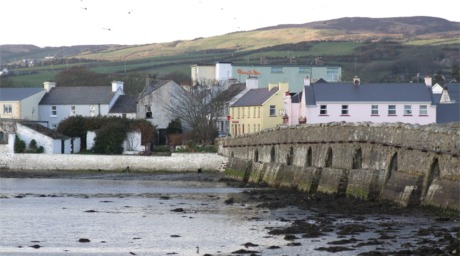|
|
Lonely Planet's thumbs up to
Inishowen
22.01.12
Report: Inishowen Independent
LETTERKENNY might have been slaughtered by the new
Lonely Planet Ireland tourist guide, but Inishowen
gets the thumbs up from the renowned guidebook.
Inishowen is a “remote, rugged, desolate and
sparsely populated, making it a special and quiet
sort of place” author Etain O’Carroll writes.
Malin Head comes in for particular praise, comparing
favourably to Ireland’s southernmost and westernmost
points. “It’s great for wandering on foot, absorbing
the stark natural setting and pondering deep
subjects as the wind tries to blow the clothes off
your back. Bring cash with you, as there are no ATMs
here.”
The 'Plantation village of Malin' is described as
having a tidy village green and “pretty movie-set
quality” to it, while local hostelries also coming
in for praise. |
 |
|
Malin Village is described as having a
“pretty movie-set quality”. |
The promoters of
Buncrana as a centre for John Newton and the Amazing
Grace story will be pleased with a large chunk of
the section on the “busy but appealing” town dealing
with the links between Buncrana and the 18th century
slave trader who composed the well known hymn.
O’Doherty’s Keep, Buncrana Castle and Ned’s Point
(“built by the British and now under siege from
graffiti artists”) are also noted, although there is
no mention of Swan Park or the coastal walk past Fr
Hegarty’s Rock to Stragill Strand.
Carn gets faint praise, and, according to the
author, isn’t a “choice locale in these parts”. That
said, the town’s Donagh Cross is described in some
detail.
While Culdaff is a secluded village where “sheep
vastly outnumber people”, its nearby historic sites
such as Clonca church, Bocan Stone Circle and the
Carrowmore High Crosses all get a good mention.
“The busy little fishing port of Greencastle” also
features, with the eccentric collection of artefacts
at the Inishowen Maritime Museum and Planetarium
coming in for a special mention.
While described as elegant with old and well kept
buildings, Moville is described as “essentially a
couple of roads beside a harbour”. Ouch.
The Foyleside town is described as being sleepy,
except on holiday weekends when tourists flood in.
The Cooley Cross, the coastal walk to Greencastle,
and the summer Dylan and Beatles festivals are all
noted in the section on Moville.
Clonmany and Ballyliffin are described as “two
quaint villages that have plenty to occupy visitors
for a day or two”. Pollan Strand, Doagh Island and
its Famine Village, and the Glenevin Waterfall are
all praised, as is Ballyliffin Golf Club where the
scenery is so beautiful that even the most focused
of golfers can be distracted.
St Mura’s Cross is the only mention Fahan gets in
the book, but Inch Island fares better: “Few
tourists make it to residential Inch Island,
accessible from the mainland by a causeway, but it’s
worth a detour for its bird-life (especially swans),
two small beaches and the remains of an old fort,”
the author writes.
Grianán of Aileach and its history is described in
some detail, with the author so overwhelmed by the
view that she loses all sense of perspective and
distance.
“Grianán offers eye-popping views of the surrounding
loughs. On clear days you can see as far as Derry.”
Considering the city is only a couple of miles away
from Grianán, there clearly isn’t much wrong with
the author’s eyesight!
A visit to Derry is highlighted as one of Ireland’s
21 top experiences, with everything form the City
Walls, to Troubles and the festivals all
contributing to the overall tourist experience.
Letterkenny, however, fares less well, described as
being ruined by the excesses of the Celtic Tiger era
where mindless development resulted in featureless
retail parks, traffic problems and a complete lack
of soul. |
|

